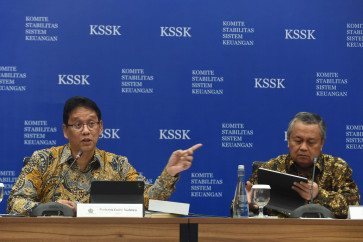Popular Reads
Top Results
Can't find what you're looking for?
View all search resultsPopular Reads
Top Results
Can't find what you're looking for?
View all search resultsReligiosity and the festivity of blood
A row of women, mostly above 30-years-old, enthusiastically joined a circle of spectators around the slaughtering spot
Change text size
Gift Premium Articles
to Anyone
A
row of women, mostly above 30-years-old, enthusiastically joined a circle of spectators around the slaughtering spot. They wore slippers and most of them had sarongs as their long-skirts. Some of them had contributed to buying cattle for the offerings.
The commotion of people chatting suddenly stopped as the religious leader started to recite prayers and sayings prior to the slaughtering of the animal. Standing with a sharp, slim but long knife in his right hand, he seemed very accustomed to completing his job.
He led the people to repeatedly recite the laudation, Allahu akbar (God is great), in a familiar monotonous rhythm.
In front of the cow, facing toward kiblat (direction of Muslim prayer), he bent down. His left hand felt for the required spot on the cow's neck while his right hand, tightly holding the knife, lifted. In seconds, it was done.
The blood of the slaughtered cow sprayed across the soil and grass, forming a small blood-red puddle. The recitation gradually faded. It was time to get the next cow ready, which kept mooing around six meters away, as if it knew what was going on.
Meanwhile, the row of our women moved forward to approach the puddle of blood. They lifted their sarongs and washed their feet with the warm blood. There was a kind of satisfaction on their faces.
My mother told me about the belief that the blood would cure or 'beautify' their feet. The blood-prints on their feet would be evidence of their sacrifices before God.
I started watching the rituals in my fourth year in primary school, but I questioned them.
Why should be there blood in the offering in the name of sacrifice? How do we know that God wants to see blood everywhere instead seeing Muslims directly helping the needy with love and affection? If it is intended as charity, aren't there better ways?
Anthropology might help us with an explanation.
Bloody sacrifice has played a central role in many ancient religions. The ancient Greeks sacrificed goats, sheep, horses, dogs and cattle.
These sacrifices were then followed by a celebratory meal as a way of establishing communion with the gods.
During the earliest period of Hinduism, priests offered humans, animals and plants in their sacrificing rituals. The ancient Chinese offered domestic animals and food to their gods and ancestors and at times also sacrificed humans.
The Aztecs, in the 16th century, offered human sacrifices to the sun God. The bloody ritual took as many as 20,000 lives a year. They mostly sacrificed the prisoners and at special times some warriors volunteered themselves. Even for the god Tlaloc, they sacrificed children.
In Buddhism, there has never been a practice of bloody sacrifice. Instead, Buddhists make offerings of incense, lighted candles and flowers as expressions of their devotion to Buddha. Sacrifice was also found to be essential in ancient Judaism until the first century. Two of the most sacrificial rituals were for thanksgiving and atonement.
In Christianity, the death of Christ on the cross is considered the perfect sacrifice in order to expiate the sins of humanity.
But why should there be blood?
Sacrificial acts, say contemporary scholars, are possibly related to religious symbolic and functional significance. First, sacrifice serves as nonverbal communication between human beings and their gods and is functionally related to certain economic values that are then institutionalized into a tradition.
Second, sacrificial rituals serve as a means to glue together the structures of certain human relationships or act as a unifying tradition in the daily lives of the people who perform them.
However, there is something interesting in how the sacrificial ritual called 'Abraham's sacrifice' was conducted. For Muslims, this story inspires their current practice of sacrificing livestock.
Ishmael, the son of Abraham and his second wife, Hagar, were asked to be sacrificed as an offering before God. Yet, when Abraham was fulfilling his task, Ishmael was saved and substituted with a fat-tailed sheep.
If we look more closely, there was a historical juncture in this story. The tradition of sacrificing human beings was amended with the sacrificing of livestock. A human life was regarded as more valuable than before.
The story might also serve as a potent argument in the diffusion of Islam in many parts of the world. As sacrificial rituals were found in almost all local traditions, the encounter in this story was smoothed and respected. It also explains why there are diverse traditional features in conducting ritual and related celebrations.
Unfortunately, the evolution of the sacrificial ritual seems to have stopped. Publicly pouring blood on the earth remains the most important part of it. We know there are people who are hoping for spirituality, without blood.
The writer is a researcher at the Center for the Study of Religions and Peace (PUSAD), at the Paramadina Foundation, Jakarta.










